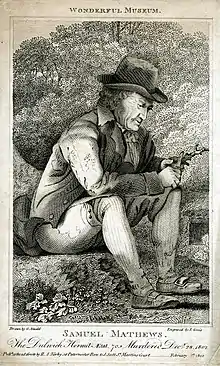Samuel Matthews (hermit)
Samuel Matthews (died 1802) better known as the Dulwich Hermit was an 18th-century London hermit, famous for his unresolved 1802 murder.

Biography
Matthews was born in Wales about 1733[lower-alpha 1] and came to Dulwich in 1772, being employed as a gardener. He was described as having led a happy domestic life - living with his wife and four children.[4]
Upon the death of his wife in about 1775, he is said to have entered a deep melancholy and have withdrawn from civilization, making his residence in a small cave in the nearby Dulwich Wood. He was visited regularly by locals who described him as quiet, friendly and learned man - quite apart from his savage and dirty surroundings. At around 1798, he was beaten by some local Gypsy boys and robbed of 12 shillings, leading to him spending a year and a half with his son in Wales, after which he returned to his Dulwich cave.[2][5]
On an unknown day in December 1802,[6] five boys came across the mangled corpse of Matthews near his cave. He had been beaten to death. "[he] was covered with fern and under his arm was an oaken branch about six or seven feet long, which it is supposed the villains put into the cave in order to hook him out…it appears likely the hook had been hitched into his mouth, there being a hole of the size of it quite through the cheek" according to the local newspaper report.[6]
Matthews had been seen the previous night by the local butcher, where he had paid off a small debt. Nearby gypsies were tried as suspects, but none were convicted, leading to the jury's verdict being "wilful murder, by person or persons unknown".[2][3][4]
References
Notes
Citations
- Lyttleton, George Courtney (1804). The Modern History of England, Continued from the Commencement of Hostilities in the Year 1803. J. Stratford. p. 283.
- Anecdotes of Remarkable Characters: Old Matthews, the Dulwich Hermit. Southwark, London: J. Bysh. 1860.
- The Terrific Register: Or, Record of Crimes, Judgments, Providences, and Calamities, Vol. II. Sherwood, Jones, and Company. 1825. pp. 625–626.
- The Life of Samuel Matthews, The Norwood Hermit. Southwark, London: Harrild & Billing. 1803.
- Blanch, William Harnett (1877). Ye Parish of Cam̃erwell: A Brief Account of the Parish of Camberwell, Its History and Antiquities. E. W. Allen. p. 385.
- url=https://www.criminalhistorian.com/12-days-of-criminal-christmas-the-murder-of-the-norwood-hermit/